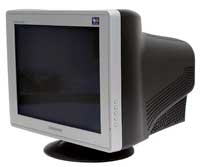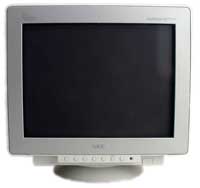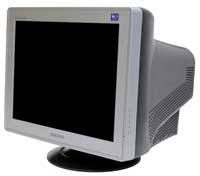Buyer's Guide - Entry Level, January 2005
by Jarred Walton on January 9, 2005 12:05 AM EST- Posted in
- Guides
Displays
For our displays, we continue to stick with CRTs due to pricing concerns - LCDs simply do not qualify as a budget part. The number of actual tube manufacturers is very small these days, as most display companies have moved on to the more profitable LCD sector, so differences between models are not all that great. What we really want out of a display is a decent refresh rate, a crisp picture, and above all, a flat surface. Convex monitors have been undesirable for over a decade, and we're more than willing to spend a bit more money in order to get a truly flat screen. This means that we're going with aperture grille displays, which some people do not like because of the two thin lines that are visible. We hardly notice the lines and will favor the flatter screens and brighter colors, but some people prefer invar shadow mask CRTs.  |
 |
| Click images to enlarge. | |
Display Recommendation: Samsung 793DF/793MB or NEC FE771SB 17" CRT
Price: $145 or $160 shipped
The best all-around option for a quality CRT is really a tie right now between the Samsung and the NEC offerings. NEC models tend to cost a bit more, but we're talking about a price difference of less than 10%. You can also find these displays at several of the larger computer stores, i.e. Best Buy and CompUSA, and when combined with special price discounts, you may be able to get them for substantially less money than we've listed here. As far as features go, both the Samsung and NEC displays are nearly identical. The NEC offers a feature called "Super Bright", which will bump up the brightness levels dramatically. It's almost painful to look at text with the SB mode turned on, but when watching movies or playing games, it actually works quite well. Samsung offers a similar feature with their "Magic Bright" technology - this is only available on the "MB" model and not on the "DF" model, however. As for the overall look, Samsung goes with a two-tone and NEC sticks with a solid color. Samsung also places the controls on the side of the monitor while NEC places them on the bottom. The two-tone color effect is one that you will probably either love or hate; personally, we think it looks pretty good and matches up with black or beige cases relatively well. As for the controls, we find the NEC positioning and menus to be more useful, but maybe we're just more used to that setup. Either one will get the job done quite well. Of course, it may be easier to find one or the other depending on where you shop.
The one feature that we miss is the lack of a 75 Hz or higher refresh rate at the maximum resolution. Unfortunately, this appears to be the case with nearly all 17" CRTs; finding a 17" monitor with a higher refresh rate is relatively difficult, and the only readily available option is Viewsonic. Unfortunately, we've heard quite a few bad experiences with Viewsonic monitors - many report that they burn out after a few years - and so we hesitate to recommend them. We feel that most displays should easily last 5 years, if not more, so when we see a lot of comments about replacing two Viewsonic CRTs in a five year span, it makes us nervous. Besides, you can get larger displays with higher supported resolutions and refresh rates for only a bit more than a "high-end" 17" CRT. Rather than spending $180 for a 17" display with an 85 Hz refresh rate at 1280x1024, we would just as soon spend the extra $20 to move up to a 19" CRT. That brings us to our alternative display recommendation.
Display Alternative: Samsung 997DF 19" CRT
Price: $215 shipped
Moving up to the realm of 19" displays, we feel that Samsung easily wins this category. They continue to offer a perfectly flat screen, and they increase the maximum resolution to 1920x1440. That may not be the most useful resolution for practical use, unless your eyesight is far better than average, but the1600x1200 resolution at a 75 Hz refresh rate is quite good. Unlike the 17" category, there are some differences between Samsung and the chief rival NEC FE991SB. NEC continues to offer their Super Bright mode while Samsung does not offer Magic Bright. It's a relatively minor omission, however, and not worth the additional $60 that the NEC would cost. NEC also offers a lower maximum resolution of 1792x1344, but considering both brands have a 96 KHz horizontal frequency, the useful resolutions are still basically a tie. If you can afford the additional $75 or so, a good quality 19" display can last a long time.
One thing that can be somewhat irritating is trying to find maximum supported refresh rates for monitors. Some companies are better than others at reporting such values, but others like to avoid listing such information as it may not meet expectations. If you can't find the maximum refresh rates for a monitor, the horizontal scanning frequency is usually enough to let you calculate what is available. A reasonable approximation of the refresh rate that a monitor can handle at a given resolution is to take the horizontal scanning frequency in Hz (it's usually expressed in KHz, so multiply by 1000), divide it by the number of lines of output for your chosen resolution - i.e. 1280x1024 would mean divide by 1024 - and then multiply by 0.97. The last multiplication by 97% is to allow for the time taken to reposition the electron beam between lines. For 85 Hz at 1280x1024, then, the horizontal frequency will need to be 90 KHz or higher. For 85 Hz at 1600x1200, you would need a horizontal frequency of 105 KHz or higher. Faster scanning frequencies require more sophisticated electronics, which is why most 17" monitors stick with a 70 KHz frequency, 19" monitors go with 96 KHz, and 21/22" displays will have the high-end 115+ KHz rates.
Update: The Samsung monitors actually are not aperture grille displays. That would explain the price difference between the NEC and Samsung models. They are still virtually flat, just like the NECs. This makes the decision between monitors a little more important, at least if you have strong feelings one way or the other on the topic of invar shadow mask vs. aperture grille displays. How noticeable is it? Well, I've had a Samsing 997DF for a couple months and have only just noticed (after a close look) that it was not an aperture grille.











31 Comments
View All Comments
edlight - Sunday, January 9, 2005 - link
Warning for Corsair Value Select: If you want to run dual channel get one of their dual channel kits containing a matched pair. I bought one stick and another a month later, and they are totally different and won't run dual channel at all on my Asus A7V880. In fact, one is single sided and one dual sided. The memory isn't made by Corsair at all.justly - Sunday, January 9, 2005 - link
I really don't have a problem if you prefer the Nforce 3-250 chipset BUT to call the "performance and reliability" of either VIA and SiS "questionable" for a budget system seems a bit (actually quite a bit) narrow minded.If this where a overclocking or performance guide I would have less of a complaint, but for a budget guide I think you should elaborate on why these chipsets are so "questionable". Has Anandtech pionted out these "performance and reliability" issues in any reviews of either VIA or SiS, because the ony complaint I can recall had to do with overclocking.
You even mention that a Nforce 3-250 board (Epox) has "memory compatibility issues" so Nforce 3-250 is not void of "performance and reliability" issues either.
A BUDGET GUIDE is about two things "reliability and cost", performance is a "distant concern" (does this sound familiar? it should its on the first page). So when it comes to the motherboard why is "performance" now a concern (especially when performance differances between A64 motherboards seem trivial compared to other components)?
If I sound upset because of this then you are correct. I offen hear review sites hope for more competition in the chipset market (things like wishing some board manufacturer would try to make a performance board with a SiS chipset) and then I read things like this. If you really want to see some competition then the least you could do is not cut them from the market that they are targeting with their product without explaining why.
ChineseDemocracyGNR - Sunday, January 9, 2005 - link
"Intel has socket 478 parts, and these are often cheaper than the more recent platforms, but longevity is something of a concern."I agree that longetivy is a concern, but the socket 478 platform is not necessarily cheaper. Intel released the Celeron D in LGA775, starting with the 2.53GHz model (the lower ones are to be discontinued in Februrary according to the Inquirer). The LGA775 is a "J" version, which adds NX support for less than $5 more compared to the socket 478 version.
Given this, I would switch the Intel budget system to the Celeron D 325J, a little more expensive than the 320. There are cheap LGA775 motherboards available, like the ECS 661FX-M7 ($53.50) and the ASRock 775V88 ($57).
Another thing I would like to comment on is the Radeon 9600Pro suggestion. Newegg is selling 400/446 Sapphire cards as 400/600 (without saying it's an Advantage card) so be careful. I would suggest these for budget systems:
SAPPHIRE ATI RADEON 9000PRO Video Card, 64MB DDR, 128-bit $46 shipped
ABIT ATI RADEON 9550 Video Card, 128MB DDR, 128-Bit, DVI/TV-Out, 8X AGP, Model "R9550-Guru " -RETAIL $80 shipped
This ABIT card comes with 3.6ns and overclocks to 500/600 (9600XT) more often than not.
bupkus - Sunday, January 9, 2005 - link
I just bought the Biostar 210V and according to their website http://www.biostar-usa.com/ideqdetails.asp?model=i... this model does support a 400 fsb. Don't expect to overclock an AXP as there is neither a voltage nor a multiplier setting in the bios. The fsb for your cpu is set using jumpers which I hope also changes the AGP/PCI ratio as I'm told are unlocked. BTW, newegg had this model for fifteen dollars less than it is now, so look for possible sale prices. Currently $154.Avalon - Sunday, January 9, 2005 - link
You can get the Samsung 997DF 19" monitor for $202 shipped at techonweb.com, I bought it there two weeks ago. If the price hasn't changed....then I'd think $202 > $215 in terms of savings.Glassmaster - Sunday, January 9, 2005 - link
Great guide Jarred!Though I would rather not have seen the RAIDMAX PSU in there, it probably won't be as big a deal for the entry level budget system. It was good to see Fortron Source being mentioned too, as a cheap but reliable PSU alternative.
You might also point people in the direction of the excellent power supply guide by computerpro3 of the hardforums. http://www.hardforum.com/showthread.php?t=792566
He lists the brands to stay away from, and those worth buying, along with links to newegg for his specific recommendations.
Glassmaster.
Spacecomber - Sunday, January 9, 2005 - link
I always enjoy reading these system guides; so, thanks for this latest one.A couple of minor comments.
I don't think that the 120mm fan on the Antec SLK1650 cases is temperature controlled. At least one of the fans in the power supply is; so, perhaps that is what you were thinking. Nevertheless, the 120mm fan is fairly quiet and becomes virtually silent, if you use 7 volts for it.
I have been a big fan of the Seagate drives, because of their 5 year warranties (started at the time when there seemed to be a trend toward 1 year warranties on hard drives). While my initial experience of these drives was how quiet they were, I have been hearing other complain of getting drives that were not that quiet. My most recent Seagate purchase was a 120GB PATA model, and I too noticed that it seemed to buzz relatively loudly when it was seeking. I don't think it is so much how loud the noise is, but it has a kind of annoying quality to it.
Apparently, Seagate is involved in a lawsuit that alleges that Seagate stole their accoustic management technology from someone else. As a result, they have disabled this feature in their current line of drives. (You can use something like Hitachi's Feature Tool to see that accoustic management doesn't show up as an option on these drives.)
So, while Seagate continues to offer a 5 year warranty, which nobody else does (except the WD Raptors), they no longer should be looked to when a quiet drive is one of your criteria, imo.
Space
Pollock - Sunday, January 9, 2005 - link
I think you should forgo the SATA Seagate and go with the IDE version, which I've seen as cheap as $59-$62, saving you $7-10 for a pointless upgrade.bigpow - Sunday, January 9, 2005 - link
Entry Level Budget & Entry Level Performance labels should make the conclusion less confusing.kmmatney - Sunday, January 9, 2005 - link
Great review. The graphics section was very good, as well as the SFF section. Nice work.Although you did mention it, I think the Athlon XP-M is the best budget cpu, with a Barton core and unlocked multiplier. It is more expensive than the Sempron, but you can team it up with a $42 Asrock motherboard and overclock it 3200+ speeds easy, even with cheapo RAM.